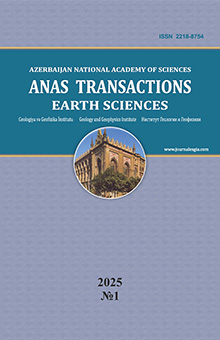Identification of oil families in horizons XIII-XV of Uzen and Karamandybas fields by oil fingerprinting analysis
Seitkhaziyev Y.Sh.1,2, DaumsharovА.А1.
1 Аtyrau Branch of LLP «KMG Engineering», Atyrau, Kazakhstan Building 10, pr. Elorda, md. Nursaya, Atyrau, Atyrau region, Republic of Kazakhstan, 060097: esimhan89-89@mail.ru
2 «Oilgasscientificresearchproject» Institute, SOCAR, Baku, Azerbaijan 88A, Zardabi avenue, Baku, AZ1012
DOI: 10.33677/ggianas20240200132
Summary
Geological exploration data indicates that effective application of available databases in combination with other methods enables to avoid drilling dry exploration wells. For instance, the integration of geochemical and geophysical data has been shown to enhance exploration outcomes by a factor of more than two when compared to the use of geophysical data in isolation. For this present study 201 oil samples were collected from wellheads of producing wells in Uzen and Karamandybas fields in 2023. The objectives of the study were (i) to assess reservoir continuity and compartmentalization studies by oil fingerprinting analysis of oils from horizons XIII-XV, (ii) to characterize source rocks of representative oil samples in terms of environmental condition and thermal maturity by biomarker analysis and (iii) to integrate the obtained outcomes to draw viable conclusion from geological point of view. Oil fingerprinting analysis showed three distinct groups in horizon XIII and four different groups in horizon XV. It should be noted that the oils from the first group (red) predominate in both horizons XIII and XV indicating good reservoir continuity between them. Biomarker analysis of representative oils showed that oils from upper horizons (XIII-XV) were generated from shaly lacustrine organic matters (OM), while those of lower horizons were from shaly marine OM(XXII-XXIV) and with depth increase the thermal maturity of oil samples rise.
Keywords: oil fingerprinting, Ward's dendrogram, sterane ternary
REFERENCES
Chemodanov A.E., Shipaeva M.S., Nurgaliev D.K., Sudakov V.A., Shakirov A.A., Ganiev B.G. Geochemical properties of the Upper Devonian deposits (Semiluk, Mendym and Kynovian horizons) of the Volga-Ural province for improving the Romashkinskoye oil field development efficiency. SOCAR Proceedings, No. 3, 2023, pp. 8-14, DOI: 10.5510/ OGP20230300881.
Dekker R., Tegelaar E., Perrotta S., Miller S.D., Varlet X. L., Hasler Narhari C.-A., Rao J.D., Neog N., Dwindt A.A., Al-Haidar S., Dashti Q. Determination of fluid connectivity in the Middle Marrat of the Jurassic Fields of North Kuwait using oil fingerprinting. SPE-188375-MS. Proc. Abu Dhabi International Petroleum Exhibition and Conference, Abu Dhabi, UAE, November 2017.
Ganz H., Hempton M. Integrated reservoir geochemistry in Nigeria. Aberdeen, Scotland, Society of Petroleum Engineers, 2005.
Ganz H., Hempton M., van der Veen F., Kreulen R. Integrated reservoir geochemistry: finding oil by reconstructing migration pathways and paleo oil-water condition. Aberdeen, Scotland, Society of Petroleum Engineers, 1999.
Mccaffrey M.A., Baskin D.K., Patterson B.A. et al. Oil fingerprinting dramatically reduces production allocation costs. World Oil, Vol. 233, No. 3, 2012, pp. 55-60.
Peters K., Fowler M. Applications of petroleum geochemistry to exploration and reservoir management. Organic Geochemistry, Vol. 33, No. 1, 2002, pp. 5-36.
Pim F., Bergen V., Gordon M. Production geochemistry: fluids don’t lie and the devil is in the detail. Geological Society, London, Special Publications, Vol. 484, 2018, pp. 9-28, DOI:10.1144/SP484.1.
Sarsenbekov N.D., Yakupova E.N., Kairbekov S.B., Seyithaziyev Ye.Sh. The role of petroleum geochemistry in enhancing multizone oil and gas reservoirs development. SOCAR Proceedings, No. 3, 2018, pp. 65-74, http://dx.doi.org/ 10.5510/OGP20180300363.
Seitkhaziyev Y.Sh. Comprehensive geochemical study of core and cutting samples from postsalt deposits of southern parts of precaspian basin and «oil-source rocks» correlation studies. SOCAR Proceedings, No. 2, 2020, pp. 30-49.
Seitkhaziyev Y.Sh. Genetic classification of oil samples of carbonate origin from fields of the southern part of the Caspian Basin. SOCAR Proceedings, No. 3, 2019, pp. 40-60.
Seitkhaziyev Y.Sh. Geochemical analysis of oil and core samples derived from oil and gas fields in the South-Mangyshlak basin. SOCAR Proceedings, No. 4, 2022, pp. 76-86, DOI: 10.5510/OGP20220400786.
Seitkhaziyev Y.Sh. Geochemical studies of gases from oil and gas fields in the southern part of the caspian basin and their correlation with the results of oil geochemistry. SOCAR Proceedings, No. 4, 2021, pp. 43-51.
Stout S.A., Uhler A.D., Boehm P.D. Recognition of and allocation among multiple sources of PAH in Urban sediments. Environmental Claims Journal, Vol. 13(4), 2001, pp.141-158.
Suleimanov B.A, Abbasov H.F. Enhanced oil recovery mechanism with nanofluid injection. SOCAR Proceedings, No. 3, 2022, pp. 28-37.
Suleimanov B.A, Abbasov H.F., Ismayilov R.H. Thermophysical properties of suspensions with [NI₃(μ₃-PPZA)₄CL₂] metal string complex microparticles. SOCAR Proceedings, No. SI2, 2023, pp.194-204.
Suleimanov B.A., Abbasov H.F., Ismayilov R.H. Enhanced oil recovery with nanofluid injection. Petroleum Science and Technology, Vol. 41(18), 2022a, pp. 1734-1751,
DOI: 10.1080/10916466.2022.2094959.
Suleimanov B.A., Gurbanov А.Q., Tapdiqov Sh.Z. Isolation of water inflow into the well with a thermosetting gel-forming. SOCAR Proceedings, No.4, 2022, pp. 21-26, DOI:10.5510/OGP20220400779.
Suleimanov B.A., Ismayilov R.H., Abbasov H.F., Wen-Zhen Wang, Shie-Ming Peng. Thermophysical properties of nano- and microfluids with [Ni5(μ5-pppmda)4Cl2] metal string complex particles. Colloids and Surfaces A: Physicochemical and Engineering Aspects, Vol. 513, 2017, pp.41-50.
Vishnyakov V.V., Suleimanov B.A., Salmanov A.V., Zeynalov E.B. Primer on enhanced oil recovery. Gulf Professional Publishing. Elsevier. 2019, 222 p.
DOI: 10.33677/ggianas20240200132
